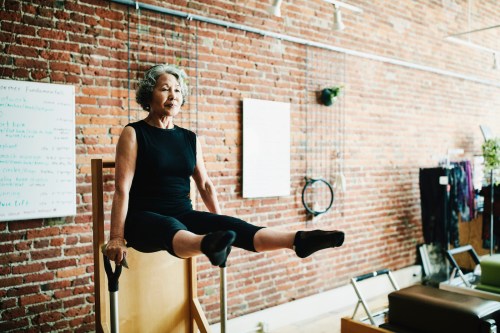5 Fitness Rules To Follow If You’re Working Out in Your 60s, 70s, and Beyond
Two experts explain what you should incorporate in a senior exercise routine when you're in your 60s, 70s, and beyond—here's what to know.

Take it from the people who continually live to be 100: Working out—even in small increments—is one of the keys to living a healthy life. As longevity becomes more and more talked about, we’re all looking for ways to live longer and better. “Your workouts should depend on your individual fitness goals and levels, and really not your age,” says Martin Ridley, physical therapist at Tru Whole Care. This is especially the case if you’ve been diligent about your fitness routine throughout your life, he says, since you won’t be starting from scratch. “Maintain 30 to 40 minutes of movement, whether it’s biking, walking, swimming, strength training, or stretching,” says Ridley.
That said, certain activities can get harder with age. “You can’t do everything at the same capacity that you used to, and the longer you don’t use muscles, the more they shut down,” says Will Torres, trainer and founder of New York City-based movement studio Willspace. And so, there are certain elements that trainers say are especially beneficial when you’re in your 60s and beyond for ultimate mobility and strength. Keep scrolling for expert-approved tips for a healthy fitness program.
5 rules to follow for a healthy senior exercise routine
1. Prioritize spinal health: The spine endures a lot over the course of our lives, so keep it top of mind when working out. The best way to do this, according to Torres? Hang. “Hanging is very important to develop grip strength, to stretch the tendons and ligaments in your arms, shoulders, spine, and neck,” he says. Also, while you’re hanging—by something like a pull up bar—gravity works to elongate your entire body, which is really healthy for your spine.
Besides hanging, Ridley advises those in their 60s and older to avoid core workouts that contract the back. “Instead of doing sit-ups and crunches, do core- and back-strengthening exercises to help the spine stand as supported and as tall as possible,” he says, noting that crunches and sit-ups can lead to back pain. Do extension-based core exercises instead.
2. Do regular yoga or Pilates: While you could turn to anything from cycling to running in your 60s or 70s, experts highly recommend incorporating regular yoga or Pilates into your routine. “We tend to recommend yoga and Pilates as the number one workout to do in your 60s and 70s,” says Ridley. “They’re both low impact and lower intensity, and your body will still feel the great effects of exercise.” Pilates and yoga both strengthen your muscles and help with your body alignment and flexibility.
3. Strengthen your hands: Torres points out that grip strength tends to lessen as you age. “We have a bunch of ways to strengthen your grip, and hanging is the best one,” he says. Another good exercise for this? The plank. “Teaching people how to put weight on their hands [through a plank] develops strength pushing in the opposite direction [of a hang],” says Torres, noting that this will also strengthen your core (as we know).
4. Do hip mobility work: Having mobile hips is key all throughout your life, but especially when you’re over 60. “Your body gets used to sitting,” says Torres (thanks for nothing, desk jobs). He says that this tends to happen if you’re not using your joints to their capacity or their full range of motion (which makes them tighter and less mobile). Enter the deep squat, or what he calls a toddler squat.
“This I define as having your hamstrings resting on the calves—you’re going all the way down,” says Torres. “This works the flexibility and mobility of the hips, and it develops your postural muscles, since you’re working to keep your spine upright.” Try to do five minutes a day. He also recommends doing hip stretches regularly to stay mobile.
5. Make your fitness adaptive: According to Torres, your body wants stimulus… which isn’t exactly what you get if you only walk on a treadmill or cycle in place. By making your fitness adaptive, or in other words, by making sure that you’re not just repeating the same motion over and over again into oblivion, you can up your fitness game. Torres suggests activities like hiking and dancing as two examples of this. “With hiking, there’s all this terrain. You’re stepping over rocks, going uphill, going downhill… you’re acclimating to different terrain,” he says. “When you’re dancing, you’re twisting, and trying to develop rhythmically.” Try switching things up to get your muscles dealing with unpredictability: walk in a park uphill, downhill, or sign up for a salsa dancing class—whatever suits your fancy.
For inspo, read about Kathy Bergen, an 80-year-old track and field superstar. And here are more tips on exercise for older adults, as inspired by a 91-year-old fitness enthusiast.
Sign Up for Our Daily Newsletter
Get all the latest in wellness, trends, food, fitness, beauty, and more delivered right to your inbox.
Got it, you've been added to our email list.










